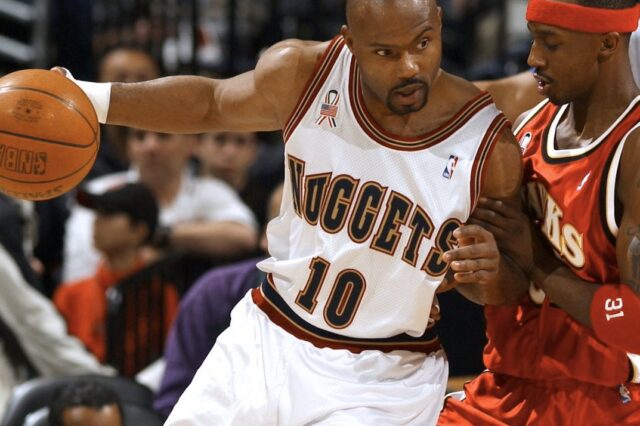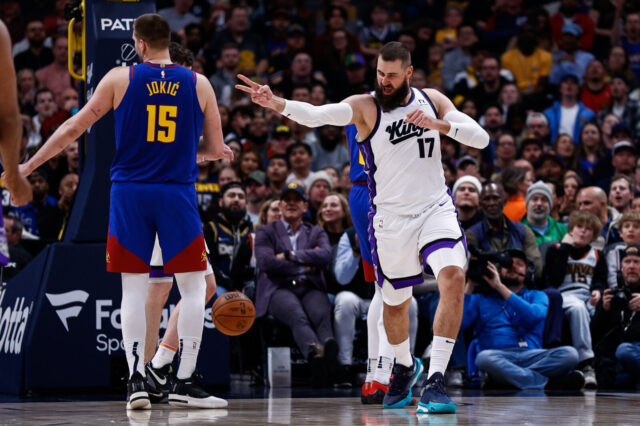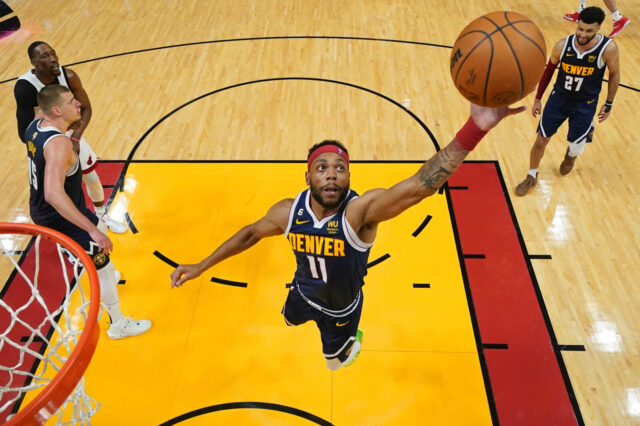Let's get these two statements out of the way.
1. The Seattle Supersonics were arguably the best team in the NBA in 1994 (better than the Rockets). In 1993, even with the Chicago Bulls (w/ Michael Jordan) the Sonics may have been the best team in basketball.
2. Dan Issel out-adjusted, out-maneuvered and out-coached Karl thoroughly and completely in the first round series versus the Sonics.
Now that those two statements are out of the way. Let’s explore what we can learn from that Sonics squad and this Nuggets version of the Denver Nuggets. You will find, upon analysis, that these two teams are remarkably similar.
First of all, let's start with a video … shall we?
1994 WCQF Gm. 4 Sonics @ Nuggets pt. 1 (via ScottPippenBulls)
*Note: If you follow the links in the description you can watch the entire Nuggets/Sonics series from 1994 on youtube, and it's a very fascinating document of a very important moment in Nuggets history. I highly recommend watching every game
I chose game four of this series because you got the best of both teams in this game. The first two games in Seattle the Nuggets were over-matched and not used to the Playoff spotlight (although they played significantly better defense in Game 2… more on that later), and in Game 3 a notoriously poor shooting team (the Nuggets) couldn't miss a shot and Seattle was kind of on auto-pilot. In Game 4 the Nuggets were peaking (defensively) and the Sonics were still confident, but not desperate like they were in Game 5.
You will see in this video that the Nuggets true identity as a team that couldn't shoot came to the forefront. However, the Nuggets defensive strategy against the more-talented Sonics team was still effective in shutting down the high powered Seattle team. It really was the best example of a "game" in the entire series.
Think of the 1993-1996 Seattle Supersonics as what Karl wants this Nuggets squad to be. Same offense, similar types of players, same defensive scheme (including leaving the three point line open). You can make a very convincing (and accurate) argument that Gary Payton and Shawn Kemp would stand head and shoulders above, say Ty Lawson and Kenneth Faried. However, let’s, for the sake of argument, explore style over talent at this point. The correlations are quite striking in execution and substance, and you will notice an eerie similarity between the two squads as you watch the videos. While it won’t surprise anyone that Karl would try to recreate the ghost of his best teams, the extent to which the replicating has gone on is startling.
Like these Nuggets, the 1993-96 Sonics had an abundance of wing players (Detlef Schrempf, Nate McMillan, Ricky Pierce, Kendall Gill, Vincent Askew) athletic forwards (Kemp, Sam Perkins) players who could play both the three and four position (Schrempf, Perkins, Kemp) guards that could fly (Payton) and the best defensive guard in the history of the game (Payton). One difference is the Sonics team lacking a true center, thus playing the 6’9″ Michael Cage at the five.
In the Karl system, however, the center is the least used position on the floor. Instead he relies on the guard to penetrate the lane to create open looks to the basket. Everything in the Sonics offense hinged on Payton’s ability to break teams down … which is what Lawson is supposed to be doing with the Nuggets. The primary difference between Ty and Payton (The Glove) was defense. However, there is the glaring problem. Guard penetration tends to get nullified with “lane packing” or having a dynamic shot blocker. Think Serge Ibaka or this man:
Dikembe Mutombo Blocks 31 Shots in 5-Game Series (1994 Playoffs) (via LamarMatic)
You see, here was the rub (if you’re an old Supersonics fan). Every major (correct) adjustment that was made in this short five-game series was done by Issel. During Game 2, he recognized that the Sonics were going to keep funneling everything to the paint if the Nuggets kept their standard man-on-man defense. Mutumbo was inevitably going to be drawn out of the lane if that happened because Michael Cage wasn’t your typical post up center. So after halftime in Game 2, Issel started funneling everything toward Dikembe by cutting off the wings with ball pressure by Reggie Williams and Bryant Stith, leaving Mutumbo to keep an eye on the paint because Cage wasn’t an offensive threat. This cut off Kendall Gill and Nate MacMillan for the most part and limited the starting offense to Schrempf, Kemp and a minimized Payton.
Teams, as you know, do this to the Nuggets. However, rather than cutting off the wings to a dynamic center who can block (only team that really employs this strategy is Oklahoma City) opposing teams pack the middle third of the circle and force Lawson to keep the ball on the outside. When this scenario presents itself, there is a very big key to what SHOULD have saved the Sonics, regardless of what the Nuggets did defensively.
While in the current NBA we are obsessed with making threes or short twos, there is a vast middle ground of shot making ability that goes woefully under-utilized. The 1993-96 Sonics were great at hitting mid-range shots (particularly Schrempf and Payton) and it made the offense, when clicking, virtually impossible to stop. This is why Ty and Danilo Gallinari are so important to the Nuggets. Gallinari has an ability to do just about everything on the court, and in order for Karl’s offense to work he needs Gallo to hit open shots. However, they need Gallo to hit MID-RANGE shots more often … not threes. This will open up all other avenues of offense. Andre Iguodala can take on the McMillan role but do it in a much more dynamic and substantive way.
Remember The Sonics: Amazing 2nd Half vs Utah Jazz (1993 WCR1 Game 5) (via Larry Bird)
This was the 1993 Sonics (arguably the best of all Karl's Sonics teams). Notice all the mid-range jumpers? If the Nuggets open up this aspect of the offense (and you can see Lawson just beginning to explore that right now) then the Nuggets offense will go from good to great.
Also, the law of averages dictate that the three-point shots that have been hit against the Nuggets will dissipate as the season progresses. This, in turn, will even out the Nuggets three point gaps they have suffered of late.
One thing that MUST be stressed at this point. The Nuggets are a good team with the potential to be VERY good. While we focus on their flaws, we need to understand that what the Nuggets do well keeps them in every game they play (except the San Antonio Spurs game). The “talent” gap on the Nuggets is not that appreciable and drastic changes, by no means, need to be made. The Nuggets are on the verge and if they overcome this horrendous early season schedule they will be one of the best teams in the Western Conference. No doubt.
One caveat. George Karl MUST learn how to use his big men appropriately. I am dead serious when I say Issel out-coached Karl in 1994. Issel, during his first tour as coach, was vastly underrated for getting the most out of his talent … and if he didn’t lose an epic battle for control of the organization to Bernie Bickerstaff in 1995 things may have been different for the Nuggets in the 90’s.
Karl must adapt and learn on the fly. Understand that while his talent now is remarkably similar to his Sonics teams, their are different elements (JaVale McGee , Kenneth Faried) that need to be adequately exploited for the Nuggets to reach their FULL potential.
Will Karl be able to do that?
***
Stiffs Night Out! December 9th – Nuggets at Knicks
Come join us at Jakes Food and Spirits!
Twitter: @jmorton78 https://twitter.com/#!/jmorton78


